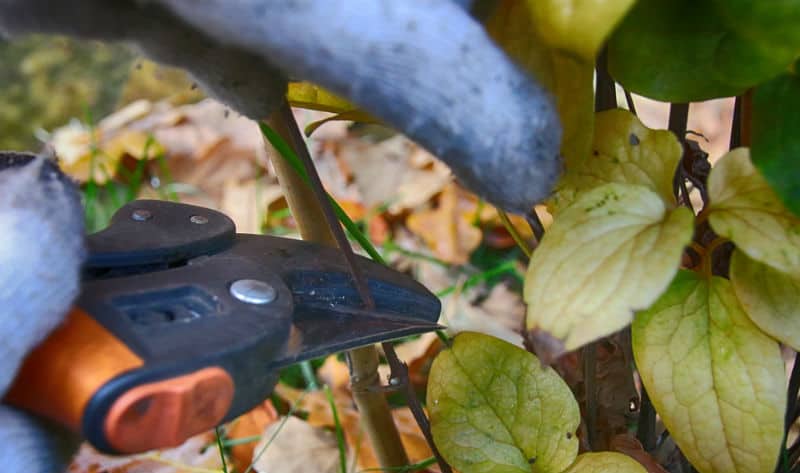Last updated on April 4th, 2022
Our site is reader supported, this means we may earn a small commission from Amazon and other affiliates when you buy through links on our site.
Happy and otherwise thriving clematis vines will give your garden a collection of stunningly colourful flowers, but when things are not going well for the clematis, it might not bloom. It can be difficult when things do not go as planned, and even more challenging to figure out why your clematis hasn’t produced any flowers. Clematis are generally easy to grow and produce masses of stunning flowers, however, there are times when they don’t seem to produce flower buds and flowers.
In order to encourage flowering, you need to determine the cause behind the lack of flowers.
Too much fertiliser causes the clematis to concentrate on producing foliage rather than flowers
Incorrect feeding is the most common reason that a clematis doesn’t produce flowers. Most of the time the problem isn’t that you aren’t giving your clematis enough fertiliser, it’s that you’re giving it too much. As a rule, most clematis will do well if you give them a mixture of 5-10-10 in the spring in conjunction with a layer of compost.
You can give them a water-soluble fertiliser once during the Spring and again during the summer, however, if you give them too much fertiliser, specifically too much nitrogen, it can reduce or eliminate entirely the blooms you get.
We recommend you buy a specialist clematis fertiliser and follow the instructions carefully to prevent overfeeding.
Our recommended clematis fertiliser
- BALANCED FEED: Vitax Clematis Feed fertiliser is a balanced feed designed to promote vigorous growth and prolific flowering in clematis and other climbing plants like honeysuckle, passion flower, and ivy.
- RICH IN NATURAL NUTRIENTS: Enriched with potassium and essential nutrients Vitax Clematis Feed Supports robust plant development and abundant blooms.
- EASY TO USE: Vitax Clematis Feed comes in a convenient pelleted form, making it easy to handle, simply apply directly to the soil and water well.
- SUITABLE FOR NEW AND ESTABLISHED PLANTS - Designed for clematis plants of all maturity, meaning optimial growth and strength against disease, regardless of their stage in life.
- EASY APPLICATION: Apply in March and repeat every three months during the growing season. Sprinkle evenly around the base, work into the soil, and water thoroughly. Ensure fertiliser does not lodge on leaves and stems for best results.
Learn more about feeding clematis in this guide by clicking here
Young clematis can take a couple of years to flower
Another reason your clematis hasn’t produced the flowers you are waiting for could be the age of the plant itself. If you have a brand-new clematis, be patient, especially if it was a young plant or cutting. Sometimes it takes a few years for the plants to really establish healthy roots. It can actually take 1-2 years for a brand new, healthy clematis to produce blooms and even longer to reach maturity as it concentrates on establishing a root system.
On the other hand, if you have an older plant that you have had for years, it simply might be at the end of its life span, unfortunately, unable to produce any more flowers. One way to help find balance is to rotate new and old clematis accordingly so that older plants are replaced with newer plants a few years in advance. This rotation allows the older plants to finish out flower production while the younger plants are establishing themselves.
Clematis need plenty of sunlight but also like to have their roots shaded
Remember that clematis like to have the top of the vines in the sun with the roots in the shade. This is a very important rule. So, sunlight exposure and lighting could be a problem, and if your clematis isn’t doing well make sure you protect the roots. Too much direct heat and sunlight around roots could reduce flowering. You can help this by planting some perennials around the base, adding a layer of gravel around the base, or using some wooden shingles propped up around the stem to create a protective tent.
Again, on the other hand, if your plant previously flowered just fine and now it isn’t, check to see if maybe a nearby tree or shrub is currently blocking the amount of sunlight it once received. You might need only a quick trim for the plant to get better access to sunlight.
Correct Pruning
Speaking of quick trims, improper pruning is another reason that certain flowers don’t manifest. There are two very specific types of clematis, one of which produces flowers on the wood from the previous growing season and if you conduct heavy pruning in the spring you might accidentally cut away the older wood that you needed to produce the flowers.
Other varieties of clematis produce flowers on the current year’s wood but if you don’t know which type you have, it is best to avoid pruning until late in the spring so that you can figure out where the flowers are growing and therefore which wood you can cut.

Learn more about how to prune clematis in this step by step guide
Making sure that you plant your clematis appropriately with the right amount of sunlight, the right amount of fertiliser and undertaking the correct method of pruning will go a long way towards ensuring blooms year after year.
Image credits – Shutterstock.com
Last update on 2025-12-20 / Affiliate links / Images from Amazon Product Advertising API



